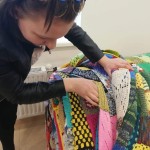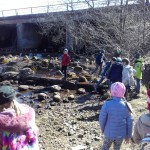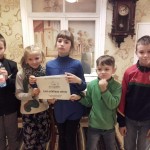Reflection on THE position of L. Ranāne McKashan in secondary school activities under the “Latvian School Finish”

As the winter stepped back, the snow woke up and greeted the pedestrians, and we shrugged and went to look at Latvia's magnificence and fortune with the school bag.
On April 10, the 5 th, 6 th class students went to know Madona. In the guide of the Guida, the pupils met the oldest street of Madona City, as well as the stock exchange and its history, at the museum surveyed the independent exhibition that exhibited exponents from the Lake Luban Lake. He listened to the narrative of the People's suits and looked at them.
The museum had an opportunity to see an exhibition of both Latvian and foreign artists. With great enthusiasm, the children surveyed the 19 th century and the footwear exhibition, saw an exhibition of bird and bird eggs in Latvia. The exhibition that could see ancient archaeological findings (jewelry, axes, etc.) was highly liked. From the Madona Museum, we saw the idea of designing clothes and accessories in preparation for an annual fashion look at school.
The children participated in the museum pedagogical programme “Welcome Latvia”, during which they had the opportunity to show their existing knowledge of Latvia's history and nature, as well as to find out something new. With a large number of children, the pupils participated in an exciting play “Welcome Latvia” - there was an opportunity to compete with each other in Classes 5 and 6 – to show their knowledge, to examine attention, to listen and to respond quickly. An intense struggle won a friendship.
The museum pedagogical program encouraged students to learn more about Latvia, respect and love their native land, care for its cleanliness and beauty. In the course of the big talent we took a Green Week at school – we set up the school surroundings, planted flowers and trees. On the day of sports we did not only physical tasks but “sharpened” the mind and did a variety of tasks for Latvia.
On April 10, as part of the “Latvian School Finish” initiative, students in Classes 1-4 went to Rezekne Theatre “Joriks” and visited interactive exhibition “Spocus copy”. The Atractive and enthusiastic ghost managers Vita and Walter introduced the most drastic spots that appear in children aged between six and twelve. Walter and Vita discovered the true reasons for her arrival, encouraged her to be happy, sad, and wonder, imagine and fantasy.
The children were surprised by the fact that Vita and Walter found a ghost house (Normunds), talked about so many ghosts (Raimonds), the theatre ghost looked for a place and pushed New_Zealand (Victoria), the stars (New Jdana, Vladislav, Adriana), the actors slipping out of the door in the wall (Atis). The children liked the ghost's ballerina (Sophie), a ghost sock and a ghost with glasses (Normunds), a show and a ghost who ate the chews (Adrian, Victoria), Valdis read the book, and Vita turned it out (Vladislav), ghosts were funny and crazy (Atis, New_Jdana). The children will remember that the ghosts don't need to be afraid (Sophie), the ghosts are good (Normunds), many ghosts for their whole life (Raimonds, Adriana), that you don't need to laugh at the theatre all time (Egon), that ghosts aren't really (Atis).
The ghost stories seen and heard in the 4 th grade encouraged their own ghost stories.
Two very sweet and friendly ghosts once lived. Ghosts met me. I was afraid! Ghosts said they were friendly and wanted to be friends with me. One was a Russian ghost, the other was a Latvian. They didn't understand each other because they didn't understand each other's language. They both spoke in Latgalian. I was a Latgale. I could speak Latvian, Latvian and Russian. I could talk to one, both ghost and two ghosts together in Latgalian. I met ghosts and lived happily!
Victoria Vandiša
Three small ghosts once lived. One was sad, the other was ridiculous, but the third was elegant. One summer day, the eating ghost ate everything he saw. The brothers said, “It's enough to eat!” You'll stay fat and don't go anywhere. '“I want and eat!” I'll eat you, too! Ha! Ha! Ha! "said the elegant brother. The sad ghost said,“ Please eat rice! ”We're not going to go to you!' A moment came when the eating ghost grabbed his brothers and wanted to eat them.“ Ņam! ”“ Ņam! ”“ Ņam! ”When the brothers began to call,“ Please! ”Please! Don't eat us! The eating brother was frightened, shouting and screaming. He promised his brothers that he wouldn't be so eager. The brothers were very shocked and friendly.
Adriana Sabanova
I went to the forest once after the mushrooms. I heard horrible sounds in the woods. I was afraid of ghosts. A ghost emerged from my eyes. He scared me very much. The Ghost grabbed me and carried it to my home. I woke up in a strange house. I couldn't remember anything because i was faint. The bad ghost had caught my whole family. Well, we were all saved by Gore Gore, who had a house key. He agrāk lived in this house.
We got the bad ghost, but we sold the house. It was all very good!
Atis Rudzītis
A lot of ghost lived in the ancient times. They were very scared. The ghosts were afraid. No one liked them. All of them were hiding. One day ghosts wanted to leave town and live somewhere else. So they went, days and nights. They finally found one big house. The ghosts went inside and saw that nobody was living in the house.
They lived in this house for long and happy!
Raimonds Tuch
The seen and heard encouraged not only to make up their ghost stories in the hours of the Latvian language, but also to draw different ghosts in the hours of visual art.
On April 11, the 7 th, 8 th, 9 th class students went to Daugavpils to look at the residents of Latgale zoo and explore the science centre ZINOO.
The world of diverse animals in Latgale zoo pupils was helped by a knowledgeable guide who, with his interesting narrative, was able to excite everyone. The rooms are small, but the exhibition is very diverse. A little scared, but it was interesting, however, that most animals were not separated from the visitors. The pupils were best liked by the ants of the ants, which were the size of the room and the mysterious tree cavities. The pupils also looked at exotic animals: different types of snakes, Cayman, fish, spiders, tarakans and turtles.
In class 8 students, the practical knowledge of biology could be linked to the zoo seen.
AT THE centre OF ZINOO, the pupils were enthusiastic and curious, surveyed and tested all the scientific achievements offered in the centre. The opportunity to experiment allowed answers to be found on various topics related to physics and art (Drawing and Music). This kind of lesson deepenes and expands the knowledge of students at an hour, increases their interest in learning subjects, Creates pupils for independent creative work, develops their initiative.
ZINOO Center is a great place to spend time with his classmates. The knowledge and experience acquired will be used by students and will be able to continue to be used in natural sciences, visual arts, mathematics, sports, music and classes. The versatile knowledge and experience of pupils can be used on a daily basis.
On 16 April, high school students went to the Museum of Naujenes and the Museum of History and Art of Kraslava.
The diversity of exhibitions offered by the Museum of Naujen surprised the exhibitions of nature, history and art. During the attendance of the museum, young people had the opportunity to see the artist Valentine Zeiles's collection of art objects, painting the views of the Daugava circle, looking at the artist sculptures formed in bronze, clay and gypsum. The pupils surveyed the artist's collection of sculptures with interest, recognizing the various portrait sculptures.
Student Dana Radvinskaite writes:
“I learned much about Father Valentin Zeili, who represented the sculptures of various artists and respectable people. The artist's contribution is invaluable because she has put her heart into her works. I remember her saying,“ If God fills my dream, i'll give him a sculpture. ”Valentin did so because God filled her dream. We should learn from her and build her own county with heart and love. '
The museum also offered a small natural exhibition “heart Daugava”, which exhibits the animals, birds, fish baskets and insects that are present in Daugava arcs, presenting young people with Latvian nature.
Anna Maria Laizane writes:
“I was most liked by the exhibition of the River Daugava. Daugava Latvians have a holy river, it was often sanctioned in folk songs and called“ Daugava Mother ”. In terms of plant diversity, it is one of the most interesting areas in Latvia."
In the exhibitions “Polish cultural heritage”, “wealthy farmer's room”, “Scotland, lidzikas, kacherage i other štrumenti”, history materials, tools, exhibitions on history topics are considered. Young people looked at the sewing tools, the manifold room, the ordinary farmer's house, and the tools.
The exhibitions at the museum are a good source of history and art. The acquired knowledge had already been used in the lessons of history, visual art, household and technology, as well as folklore clusters.
When he visited Kraslava on his 96 th birthday, the pupils met the Museum of History of Kraslava and the Museum of Art. Under the direction of the director of the museum, young people learned about the history of the museum, the ethnic composition of the people of Kraslava, the cultural and traditions of the city, looked at the exhibition - a “five oar boat” created in an improvised boat, symbolizing the Kraslava coat of arms with five oars.
The museum exhibition hall had the opportunity to look at Latvian culture and its roots in an exhibition “man and nature in Latvia” in the vision of Italian photographer Luka Berti.
As a result of the discovery of the natural views of the city, the exhibition of the photographs of the municipality of Evita Shcutanne was offered, with views of Kraslava and Daugava.
The museum area includes an entire complex of Count Pieter Castle, which also includes restored horse stables used as exhibition hall and a position house. The pupils visited the interactive exhibition “Pi Golda”.
During the visit of the Palace complex, young people were given the opportunity to look at the castle. Here, in an externally restored palace, the truth about the consequences of human harmful conduct looked at the sight. Unfortunately, the inner rooms of the castle were not preserved, but the pupils were looking at what was left and the plans and the proposed plans thought how these rooms could look.
The exhibitions seen in the museum and the accumulated historical heritage are a great insight into the history of Kraslava and also the Latvian border. The exhibitions of photographs, although thematically similar but still perceptible, reveal the diversity of Latvia's natural diversity, which is useful in the learning hours of natural sciences as an opinion material.
On 17 April, students in Classes 1-4 visited THE city OF Viļānu. IN Viļānu, pupils were active in the museum pedagogical programme “linu seed story”. It was an opportunity to know the production and processing process of flax, as well as to see and feel the flax straw becoming a flax thread. When reading people's songs in both Latgalian and Latvian languages, children experienced an idea of our ancestral lifestyle, everyday jobs, tools. All together, the children painted the artist Ieva Jurisne's drawings and composed the book “linu seed story.”
IN Viļānu, the children had the opportunity to look at the permanent exhibition of the museum and the exhibition “Satekpoints” of the School of Art and Design Secondary School of Rezekne. This exhibition saw children's work in various techniques using different materials.
By storing about Viļānu cultural history objects, mentioning the words and stories about THE surroundings OF Viļānu, THE head of THE Viļānu drainage museum led to an exciting trip along THE streets OF Viļānu. Students surveyed Viļānu HES, Viļānu city council, varnish island, Viļānu lake.
The students were most liked at THE Maltas river and the bridge in the varnish salad (Vladislav), in THE Viļānu museum to listen to the story “headphones”, paint, go to the lake, and get water (Adriana), walk to the lake (Tom), the museum book, lake, and say about the fallen castle (March), say about the fallen castle (Domenica), the varnished island where we ate lunch and lake (Oscar), the painting of the book, walk along Viļāniem and walk along the forest (Nijdana), the exhibition Viļānu in the Municipal Research Museum (Normunds).
Both teachers and pupils enjoyed a lot of creative ideas for future work. In the hours of fiction, pupils wedged wall decorations using flax thread, for which they learned so much in the museum. In the hours of visual art and classes, pupils drew their impressions on what they had seen. The knowledge of HES in natural sciences was visualised. In the hours of the Latvian language, it was read about various Latvian castles.
As the closing activity of this semester was a performance after H.K. Andersen's stories, “OLE LUOIJE”, in Rēzekne City theatre-studio “Joriks”, which was visited by students of classes 5-6.
The children had a chance to know H. K. Andersen's beauty. During the performance, the actors, using unusual artistic expressions, showed the environment of different fairy tales. Students saw how many emotions, different characteristics, varied fairy images can be displayed with minimal opportunities. The performances in pupils formed an understanding of actor art, encouraged to read Andersen's fairy tales. In the literature hours, pupils told her favorite H. K. Andersen's story.
Thanks to the programme, the Latvian school bag “about the opportunity to visit so many and diverse activities. Students are happy and appreciate it.
A sunny and impressive summer that will encourage the next school year to new jobs and creative ideas!
Ingona Schulberg, co-ordinator of “Latvian School Finish” AT L. Ranāne McKashan High School


